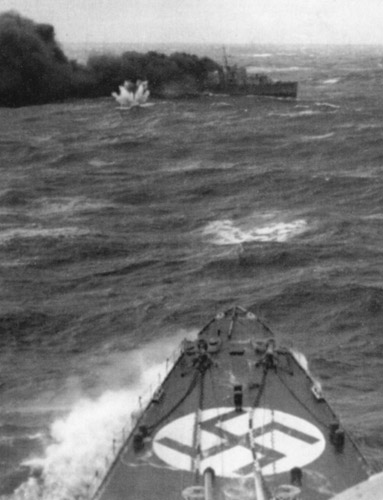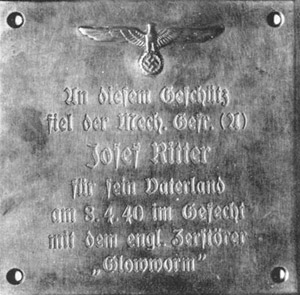Now It Can Be Told! - Last Glorious Fight of the Glowworm
The War Illustrated, Volume 9, No. 213, Page 236-237, August 17, 1945.
In one of the most daring and courageous sea-battles of the war, the British destroyer H.M.S. Glowworm, of 1,345 tons, fought a single-handed duel at point-blank range with the 10,000-ton German cruiser Hipper; then, battered and burning, she turned in a last superb gesture of defiance and rammed the giant enemy towering above her. On July 10, 1945, it was announced that Lieut.-Cmdr. G. B. Roope, R.N., the Glowworm's heroic commander, had been awarded the V.C.
 Shellburst within a cable's length of the Glowworm during the action in which, heroically, she rammed the 10,000-ton Nazi cruiser Admiral Hipper. Taken from the German vessel, the photograph shows the Glowworm laying a dense smoke-screen as she cuts across the enemy's bows. Story was released on July 7, 1945, with the repatriation of the one surviving officer, Lieut. R. Ramsay, R.N. He was awarded the D.S.O. three days later, when the posthumous award of the V.C. to the Glowworm's Captain, Lieut.-Cmdr. G. B. Roope, R.N., was also announced. Photo, Planet News.
Shellburst within a cable's length of the Glowworm during the action in which, heroically, she rammed the 10,000-ton Nazi cruiser Admiral Hipper. Taken from the German vessel, the photograph shows the Glowworm laying a dense smoke-screen as she cuts across the enemy's bows. Story was released on July 7, 1945, with the repatriation of the one surviving officer, Lieut. R. Ramsay, R.N. He was awarded the D.S.O. three days later, when the posthumous award of the V.C. to the Glowworm's Captain, Lieut.-Cmdr. G. B. Roope, R.N., was also announced. Photo, Planet News.
Only them, with the repatriation of the Glowworm's one surviving officer, 27-years old Lieutenant Robert Ramsay, R.N., did the story of this epic fight come to light. All that was known previously was that the Glowworm had been sunk by a heavy enemy vessel in the North Sea on April 8, 1940. This is what happened: The Glowworm was escorting the battle cruiser Renown when a man was washed overboard in heavy seas. In her efforts to find him, the destroyer lost touch with the main British force, and as the weather worsened she had to reduce speed to less than ten knots. Her gyro-compass failed, and she had to steer by magnetic compass. At daybreak on April 8, 1940, she was trying to rendezvous with another British force, when she sighted an unidentified destroyer.
“We immediately challenged her”, said Lieut. Ramsay, “and she replied that she was Swedish – then she opened fire”. A few moments later another destroyer was sighted, and the Glowworm began her gallant fight – against odds from the start.
The battle developed into a slamming match, with the destroyers manoeuvring at full speed and firing with all guns. “Very soon our Director Control Tower was flooded out by heavy seas”, continued Lieut. Ramsay. “The ship was being thrown about and rolling very heavily. We lost two men overboard and several were injured by the roll of the ship, but we scored a hit on the leading enemy destroyer. They didn't hit us. Shortly afterwards they broke off the action and were obviously trying to lead us on to something more powerful.”
Although the Glowworm's Commanding Officer, Lieut.-Cmdr. Gerard Roope, R.N., knew what the enemy was trying to do, he decided to follow with the idea of finding our what big ships the Germans had at sea. He hoped to shadow them and report their movements. A few minutes later, the Hipper hove in sight – the Hipper armed with eight 8-in., twelve 4.1-in. and twelve 37-mm. guns against the destroyer's four 4.7-in. guns. Weather conditions made shadowing impossible, and from then on the Glowworm knew her fate was sealed.
The sole purpose of Lieut.-Cmdr. Roope was to inflict as much damage as possible on the enemy before being sunk, and the heroic battle began.
Long before the Glowworm's guns were within range, the Hipper was pouring 8-in. shells at the destroyer and hitting her mercilessly. “We made smoke”, said Lieut. Ramsay, “and began to close the enemy cruiser. When we got within range, I fired our torpedoes.”
The Sirens Screeched Unheeded
Meanwhile, the Glowworm was rapidly becoming a blazing inferno. One of her four guns was out of action. Her range-finder was hit. The upper yard of her mast collapsed across the siren wires and her sirens were screeching unheeded in the blaze of battle and stink of cordite and black smoke. Then it was that Lieut-Cmdr. Roope decided to ram the Hipper. Going in under a storm of fire from 8-in., 4-in. and machine-gun fire, he steered for the enemy's starboard side.
There was a grinding crunch as the destroyer's bows crumpled against the cruiser's armoured plating. Men fell to the deck in a welter of blood and sea water, fire and smoke. Those who could, picked themselves up again.
 Plaque from the Admiral Hipper recording the death “for his Fatherland” of Gunner Josef Ritter during the fight with H.M.S. Glowworm, described here. Photo, British Official.
Plaque from the Admiral Hipper recording the death “for his Fatherland” of Gunner Josef Ritter during the fight with H.M.S. Glowworm, described here. Photo, British Official.
“As we drew away we opened fire once more”, Lieut. Ramsay said. “We scored one hit at 400 yards. Our bows were badly stove in. A shell had passed through the wheelhouse. Another had burst in the Transmitting Station, killing most of the crew and all the staff of the Wireless Office. A third entered the ship under the after-torpedo-tubes, crossed the ship and burst against the forward bulkhead of the Captain's cabin. The cabin was being used as a first aid station and the explosion turned it into a shambles. This shell also made a huge hole in the ship's side abreast the engine-room, and another completely wrecked the after superstructure.”
“The Captain was so far unhurt, and as the ship heeled over to starboard he gave the order to abandon ship. He sent me down from the bridge, and I tried to get as much timber and other floating material over the side as possible. There seemed to be very few unwounded, but all that could be done was done to put lifebelts on the injured men in the hope that they would float.”
“The Captain, who was the only other survivor on the bridge besides myself, then came down. E. R. A. Gregg reported he had gone down to the boiler room and let off steam to avoid an explosion as the ship sank. Then shortly afterwards – about 10 o'clock – the Glowworm capsized. After floating bottom-up for a few moments, she sank.”
“The Hipper stopped and picked up survivors. Our Captain was not among them, though he was seen in the watter. I was taken before the Hipper's Captain, who told me our torpedoes had missed his ship by only a few yards. The ramming had damaged one set of her torpedo tubes, flooded two compartments, and put her fresh water system out of action. She took us to Trondheim, but later she had to go to Germany to be docked for repairs.”
Previous and next article from Now It Can Be Told!
Now It Can Be Told! - Our "Met" Men Fought Germans in the Arctic
The arctic wastes of Spitsbergen were in 1942 the scene of a great Allied adventure – it was disclosed on June 9, 1945 – when a small meteorological party, established there to obtain vital weathe
Now It Can Be Told! - We Ferried Invasion Trains to France
While planning the invasion of the Continent it was realized that as soon as we were established on the far shore railway communications behind our lines would be of major importance and that locomoti
Index
Previous article
I Was There! - Cossacks Welcomed Us as We Entered Berlin
Prelude to Potsdam, the historic entry of the first advance units of British and U.S. occupation troops into Berlin on July 3, 1945, is indelibly recorded in this dispatch from Edwin Tetlow his first
Next article
Now It Can Be Told! - We Ferried Invasion Trains to France
While planning the invasion of the Continent it was realized that as soon as we were established on the far shore railway communications behind our lines would be of major importance and that locomoti



